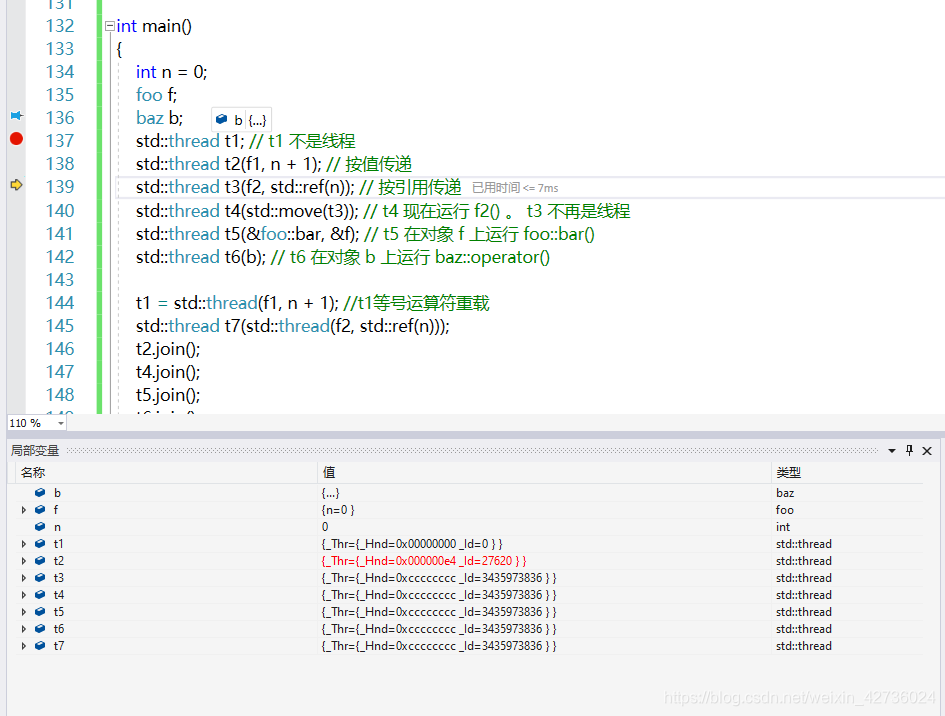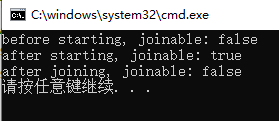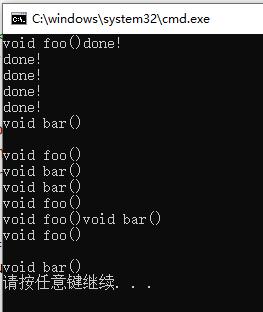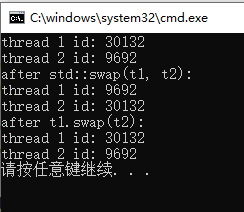在windows上面启线程时,用的是windows的API,前辈说可以去学一下C++11 提供的线程库,比较方便灵活。下面就介绍一下thread的用法。
std::thread::thread
|
thread() noexcept; |
(1) | (C++11 起) |
|
thread( thread&& other ) noexcept; |
(2) | (C++11 起) |
|
template< class Function, class… Args > |
(3) | (C++11 起) |
|
thread(const thread&) = delete; |
(4) | (C++11 起) |
构造新的
thread
对象。
1) 构造不表示线程的新
thread
对象。
2) 移动构造函数。构造表示曾为
other
所表示的执行线程的
thread
对象。此调用后
other
不再表示执行线程。
3) 构造新的
std::thread
对象并将它与执行线程关联。新的执行线程开始执行
4) 复制构造函数被删除;
thread
不可复制。没有两个
std::thread
对象可表示同一执行线程。
std::thread::~thread
|
~thread(); |
(C++11 起) |
在下列操作后 thread 对象无关联的线程(从而可安全销毁)
std::thread::operator=
|
thread& operator=( thread&& other ) noexcept; |
(1) | (C++11 起) |
这个例子是借鉴
cppreference.com
这个网站上面的,我详细的分析一下这个例子。
#include <iostream>
#include <utility>
#include <thread>
#include <chrono>
void f1(int n){
for (int i = 0; i < 2; ++i) {
std::cout << "Thread 1 executing\n";
++n;
std::this_thread::sleep_for(std::chrono::milliseconds(10));
}
}
void f2(int& n){
for (int i = 0; i < 2; ++i) {
std::cout << "Thread 2 executing\n";
++n;
std::this_thread::sleep_for(std::chrono::milliseconds(10));
}
}
class foo{
public:
void bar(){
for (int i = 0; i < 2; ++i) {
std::cout << "Thread 3 executing\n";
++n;
std::this_thread::sleep_for(std::chrono::milliseconds(10));
}
}
int n = 0;
};
class baz{
public:
void operator()(){
int n = 0;
for (int i = 0; i < 2; ++i) {
std::cout << "Thread 4 executing\n";
++n;
std::this_thread::sleep_for(std::chrono::milliseconds(10));
}
}
};
int main(){
int n = 0;
foo f;
baz b;
std::thread t1; // t1 不是线程
std::thread t2(f1, n + 1); // 按值传递
std::thread t3(f2, std::ref(n)); // 按引用传递
std::thread t4(std::move(t3)); // t4 现在运行 f2() 。 t3 不再是线程
std::thread t5(&foo::bar, &f); // t5 在对象 f 上运行 foo::bar()
std::thread t6(b); // t6 在对象 b 上运行 baz::operator()
t1 = std::thread(f1, n + 1); //t1等号运算符重载
std::thread t7(std::thread(f2, std::ref(n))); //t7拷贝构造
t2.join();
t4.join();
t5.join();
t6.join();
t1.join();
t7.join();
std::cout << "Final value of n is " << n << '\n';
std::cout << "Final value of foo::n is " << f.n << '\n';
}

可以看到只是调用默认构造函数(构造函数(1))构造线程,线程是不会被构造的,如图,线程t1没有被构造。
线程t2,t3调用构造函数(3) ,参数Function&& f, Args&&… args,f实质上是一个函数指针,保存线程所要执行的函数的地址,args是函数的参数,线程运行f(args),线程t5因为调用的是类的成员方法,this指针作为非静态成员函数的隐含形参,因此我们将this指针即就是对象的地址传进去。
线程t4调用拷贝构造函数(构造函数(2)),thread的拷贝构造函数只有右值拷贝构造,左值的拷贝构造被删除了,右值引用是指函数的参数可以是临时变量,如线程t7,由一个临时变量std::thread(f2, std::ref(n))构造t7。而t4使用的std::move(t3),其中
template< class T >
typename
std::remove_reference
<T>::type&& move( T&& t ) noexcept;
std::move返回的是一个右值引用的变量,而函数的作用是将t到另一对象有效率的资源传递,传递过后,资源t会被销毁。在这个表达式中的作用就是将线程t3的资源传递给t4,并销毁t3。
线程t6是调用构造函数(3),而这个类里面有operator()(),括号的运算符重载,只要这个对象被使用,那么就会调用括号运算符重载。
线程t1调用等号运算符重载。
最后运行的结果:


线程2-5运行了两遍,所以上面的函数分别打印了2遍,另外线程1,7又将函数f1和f2打印了2遍。
std::thread::joinable
|
bool joinable() const noexcept; |
(C++11 起) |
检查线程是否可合并,即潜在地运行于平行环境中
#include <iostream>
#include <thread>
#include <chrono>
void foo(){
std::this_thread::sleep_for(std::chrono::seconds(1));
}
int main(){
std::thread t;
std::cout << "before starting, joinable: " << std::boolalpha << t.joinable()
<< '\n';
t = std::thread(foo);
std::cout << "after starting, joinable: " << t.joinable()
<< '\n';
t.join();
std::cout << "after joining, joinable: " << t.joinable()
<< '\n';
}

我们可以看到,在线程为活跃之前,joinable的值为false,在线程活跃之后,joinable的值为true。在线程被join,detach之后,置joinable的值为false。joinable被置为false的情况有
这些情况和线程被析构的情况都是一样的,因为thread的析构函数是这样实现的

joinable为true的话,会调用terminate(),terminate()会调用abort()来终止程序,程序会报错,因此只有joinable变成false,才能执行析构函数,因此两者运行的必要条件是一样的。
std::thread::join
|
void join(); |
(C++11 起) |
等待线程完成其执行
std::thread::detach
|
void detach(); |
(C++11 起) |
容许线程从线程句柄独立开来执行。
join和detach执行的必要条件都是joinable是true。
join和detach的区别,join会阻塞当前的线程,直到运行的线程结束,比如在main函数里面调用线程thread,那么main函数里面调用thread后,会先去执行thread中的代码逻辑,直到其结束,再去执行main函数里面的代码逻辑。调用join后,所有分配的资源都会被释放。在调用了join之后,*this就不会拥有任何线程了。
detach从线程对象中分离出执行线程,允许线程独立的执行。一旦线程退出,所有分配的资源都会被释放。在调用了detach之后,*this就不会拥有任何线程了。
以上图片借鉴
https://www.cnblogs.com/ittinybird/p/4820142.html
,这篇文章也写得很好,大家可以看一下。
可能光说还是有点抽象,上代码:
#include <iostream>
#include <thread>
#include <chrono>
void foo(){
for (int i = 0; i < 5; ++i){
std::cout << "void foo()" << std::endl;
}
}
void bar(){
for (int i = 0; i < 5; ++i) {
std::cout << "void bar()" << std::endl;
}
}
int main(){
std::thread helper1(foo);
std::thread helper2(bar);
helper1.join();
helper2.join();
for (int i = 0; i < 5; ++i){
std::cout << "done!\n";
}
}

#include <iostream>
#include <thread>
#include <chrono>
void foo(){
for (int i = 0; i < 5; ++i){
std::cout << "void foo()" << std::endl;
}
}
void bar(){
for (int i = 0; i < 5; ++i) {
std::cout << "void bar()" << std::endl;
}
}
int main(){
std::thread helper1(foo);
std::thread helper2(bar);
helper1.detach();
helper2.detach();
for (int i = 0; i < 5; ++i){
std::cout << "done!\n";
}
system( "pause");
}

可以看出来,detach不会阻塞主线程,主线程和子线程是同时运行的。而join是会阻塞主线程,等待子线程运行完后,在运行主线程。
其他一些函数,不太常用,但要知道。我贴出来。
std::thread::get_id
|
|
(C++11 起) |
返回标识与 *this 关联的线程的
std::thread::id
类型值。
std::thread::native_handle
|
native_handle_type native_handle(); |
(C++11 起) |
返回实现定义的底层线程句柄。
std::thread::hardware_concurrency
|
static unsigned int hardware_concurrency() noexcept; |
(C++11 起) |
返回实现所支持的并发线程数。
std::thread::swap
|
void swap( thread& other ) noexcept; |
(C++11 起) |
互换二个 thread 对象的底层句柄。
std::swap(std::thread)
|
void swap( thread &lhs, thread &rhs ) noexcept; |
(C++11 起) |
为
std::thread
特化
std::swap
算法。交换
lhs
与
rhs
的状态。等效地调用 lhs.swap(rhs) 。
#include <iostream>
#include <thread>
#include <chrono>
void foo()
{
std::this_thread::sleep_for(std::chrono::seconds(1));
}
void bar()
{
std::this_thread::sleep_for(std::chrono::seconds(1));
}
int main()
{
std::thread t1(foo);
std::thread t2(bar);
std::cout << "thread 1 id: " << t1.get_id() << std::endl;
std::cout << "thread 2 id: " << t2.get_id() << std::endl;
std::swap(t1, t2);
std::cout << "after std::swap(t1, t2):" << std::endl;
std::cout << "thread 1 id: " << t1.get_id() << std::endl;
std::cout << "thread 2 id: " << t2.get_id() << std::endl;
t1.swap(t2);
std::cout << "after t1.swap(t2):" << std::endl;
std::cout << "thread 1 id: " << t1.get_id() << std::endl;
std::cout << "thread 2 id: " << t2.get_id() << std::endl;
t1.join();
t2.join();
}

文章借鉴:
cppreference.com